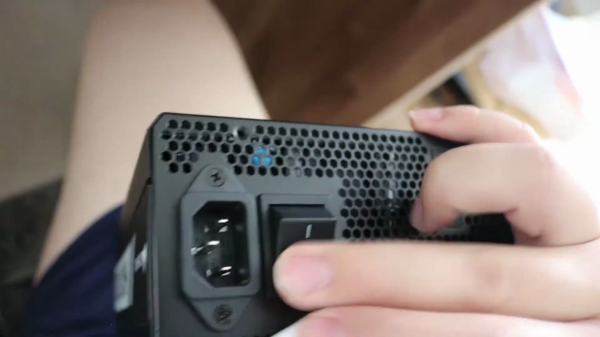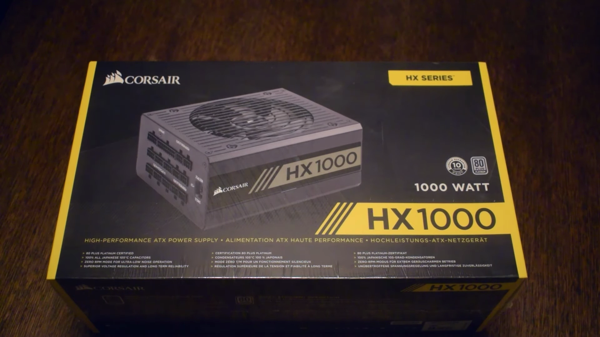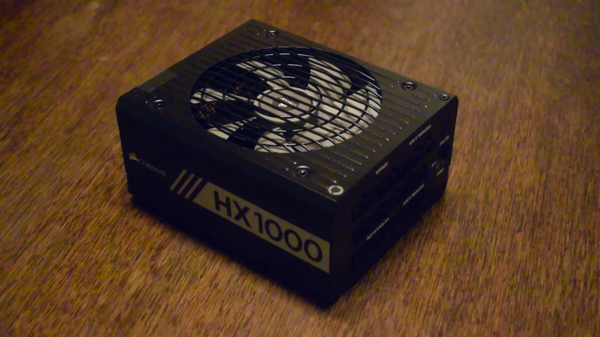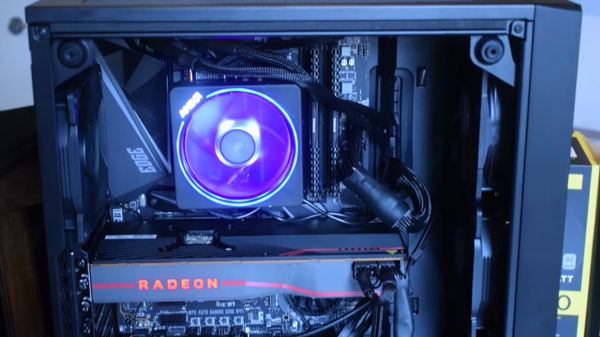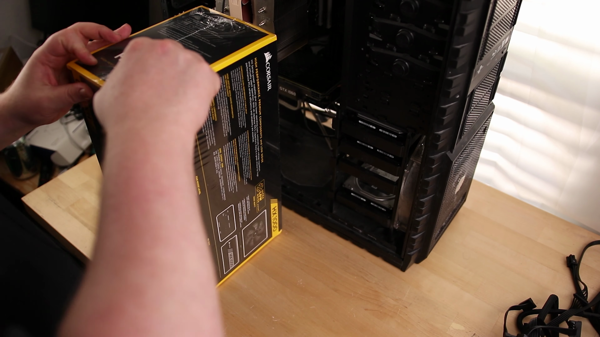Note: As an Amazon Associate I earn from qualifying purchases.
My impressions of the Corsair HX1000 1000W PSU (80+ Platinum, modular) - (2024)
Introduction
I recently upgraded one of my desktop builds with the Corsair HX1000 power supply. Corsair has quite a good reputation for high performance and quality materials - below are my thoughts on this PSU.
Specifications
| Property | Value | Property | Value |
|---|---|---|---|
| Model Name | hx1000 | Brand | Corsair |
| Compatible Devices | Personal Computer | Connector Type | EPS |
| Output Wattage | 1000 | Form Factor | ATX12V |
| Wattage | 1000 watts | Cooling Method | Air |
| Item Dimensions LxWxH | 15.35 x 8.66 x 5.91 inches | Item Weight | 1.95 Kilograms |
Photos
Click on photos to enlarge them:
Prices
Check prices of the Corsair HX1000 1000W Platinum PSU on:
Overall Build Quality

When evaluating the build quality of the Corsair HX1000 PSU, I hold a generally positive viewpoint, despite some noticeable drawbacks. The presence of all-Japanese 105°C capacitors in this model signifies a focus on durability and reliability in its design. This commitment to quality is particularly reassuring when powering a high-performance PC.
However, the build quality of the HX1000 power supply is notable. The heavy construction and refined finish convey a premium feel. Below are my observations on this power supply’s manufacturing aspects:
High-quality components: The PSU uses superior capacitors and internal parts, enhancing its durability and efficiency.
Finish: Aesthetically, the PSU has a clean and professional look, complementing any build it’s installed in.
Corsair offers a 10-year warranty, demonstrating their belief in the product’s Durability.
Unfortunately, the inflexible 24-pin cable of the HX1000 poses installation difficulties. Despite implying high-quality materials, the rigid cables can be frustrating, especially in compact cases or complex cable management setups. More pliable sleeves or cable flexibility would have been beneficial enhancements.
One specific challenge I encountered was inserting the main 24-pin connector to the motherboard. Adaptations had to be made for a proper fit, which is not something you’d expect to do with such a high-end product.
Overall, the Corsair HX1000 power supply unit showcases impressive construction in line with its high price tag. Its excellent performance and extensive warranty address concerns about potential durability problems. Although installing it involves dealing with rigid cables, the advantages of having a fully modular setup and reliable internal components overshadow these minor annoyances.
The HX1000 power supply is a sensible investment for those seeking a robust and durable solution for power-intensive tasks. Its construction inspires confidence that my PC components will receive consistent and efficient power. Although the cables are somewhat inflexible, overall this PSU is a valuable addition to my system, making it a prudent choice for anyone in need of a reliable power source.
Silent Operation Efficiency

The silent operation of the Corsair HX1000 PSU is a notable feature for me, as I prefer a quiet work environment. This power supply unit doesn’t fail to deliver in this aspect with its Zero RPM Fan Mode enabling fanless operation at low loads. It effectively operates quietly even with multiple applications running.
Here’s a simpler version:
Pros:
Under low to moderate operation, this emits little sound due to Zero RPM mode.
A Fluid dynamic bearing fan operates silently during operation.
Modular design simplifies setup and may enhance airflow, decreasing heat and fan usage.
Cons:
Cables can be difficult to route for neat cable management due to their stiffness.
Some may find the PSU is somewhat long, which could pose fitting challenges in compact cases.
These silent attributes make this PSU appealing. The 135mm thermally controlled fan runs quietly, barely noticeable during gaming or video editing. It effectively cools down the components without constant intervention.
Now, moving forward with the cables discussion, I found the modular design beneficial for flexibility. However, the rigidity of them made installing the PSU a more time-consuming process than anticipated. Particularly challenging was positioning the 24-pin connector. This could pose a considerable issue in compact cases or builds where space is at a premium.
Moreover, despite being fully modular, some cable lengths may be restrictive in a mid-tower case. Measuring out the required length is essential before purchasing, especially for larger cases or components with significant distance between them.
The HX1000’s high 80 PLUS Platinum efficiency saves energy costs and generates less heat, contributing to its silent operation. This is beneficial for me, as I focus on electricity bills and sustainability.
In sum, the HX1000’s silent operation is excellent, but it has minor issues. The inflexible cables and difficult installation may cause frustration, but the quiet and efficient performance outweigh these initial problems.
Power Output and Stability

When assessing power supplies, reliability and consistency of power output are key factors I consider. The Corsair HX1000 PSU is known for its power stability and was my choice to power my energy-demanding components such as the RTX 4090. With an 80 PLUS Platinum efficiency, this power supply ensures smooth energy delivery while also contributing to cost savings through reduced heat generation. Here’s a summary of its notable features:
Positives:
Maintaining tight voltage regulation is crucial for safeguarding connected components and ensuring their longevity.
This powerful device boasts a 1000 watts output, delivering superior performance and paving the way for future upgrades.
In Zero RPM mode, a power supply unit can operate quietly at low to medium power usage without the fan turning on.
Negatives:
Despite having a strong power supply, some high-end GPUs have produced coil whine under heavy use.
This powerful unit may exceed the capacity requirements of most common systems, resulting in overcapacity and potential underutilization.
My experience is different from what the product description would have led me to expect in some respects. The rock-solid stability has been an absolute boon. It’s a reassurance that even with spikes in power demand from the latest GPUs, this PSU doesn’t break a sweat –a testament to the unit’s robust power output capabilities. However, the coil whine reported by some users, even when the unit is well within its operating capacity, is a concern. While it has not impacted me personally, it’s a point worth considering if complete silence is a priority for your setup.
Another aspect I value is the unit’s ability to generate excess power. This provides me with confidence for future expansions without worrying about power limitations. However, this might be considered unnecessary by users without significant power requirements.
Ultimately, the Corsair HX1000 stands out as a reliable workhorse that’s likely to outlast several PC upgrade cycles. The high output wattage it provides, while a tad overkill for my current setup, offers an excellent safety net for anticipated future needs. While there are minor downsides to consider, such as the potential for coil whine, in my usage, the PSU has performed consistently and reliably, living up to its promise of delivering top-tier power output and stability.
Installation and Cable Management

When I chose to add the Corsair HX1000 PSU to my system, I acknowledged the installation complications and potential cable chaos that could ensue. To mitigate this, I focused on implementing effective cable management practices throughout the build process. My actual experience was mostly favorable, with the well-designed modular cables of the HX1000 making cable management a more manageable task than anticipated.
Here’s a quick rundown of my experience:
Easy Installation: The modular design allows for a tidier build by connecting only necessary cables. This leads to an improved appearance and better airflow within the case.
Cable Flexibility: The cables provided are quite stiff. This rigidity did pose some issues in bending and routing them satisfactorily around the corners of my case. In particular, the 24-pin connector demanded some muscle to get it to fit snugly against the motherboard.
Cable Length: I found the cables to be of sufficient length for standard cases, but if you have a larger case or unique routing requirements, it might be a tight squeeze.
The build process was facilitated by the modular nature of the system, which ensured a straightforward assembly experience. Despite challenges, this modular design led to less cable clutter, enhancing both comfort and efficiency during assembly. The clear labeling on the power supply unit further simplified cable connection in this modular setup.
For those considering this power supply, there’s a potential issue: The stiff cables may cause difficulties if you’re working in a compact case or have limited space for cable management at the back panel. I encountered similar challenges when connecting the graphics card, which requires multiple 8-pin connectors, making what should have been an easy task into a somewhat frustrating experience. However, it is essential to be aware of this issue before purchasing.
In terms of connectivity, the Corsair HX1000 offers numerous options for connecting various components and devices. You won’t encounter a shortage of connectors even with a complex gaming setup or multi-GPU configuration.
In closing, the Corsair HX1000 PSU handles installation and cable management adeptly, but not without a couple of niggling issues that could be improved upon. For future models, it would be appreciated if Corsair could provide more flexible cables without compromising on quality. This would make the installation process smoother and alleviate some of the concerns when it comes to managing those cables neatly. Despite these challenges, the benefits of the fully modular system and clean design ultimately contribute to a positive building experience.
